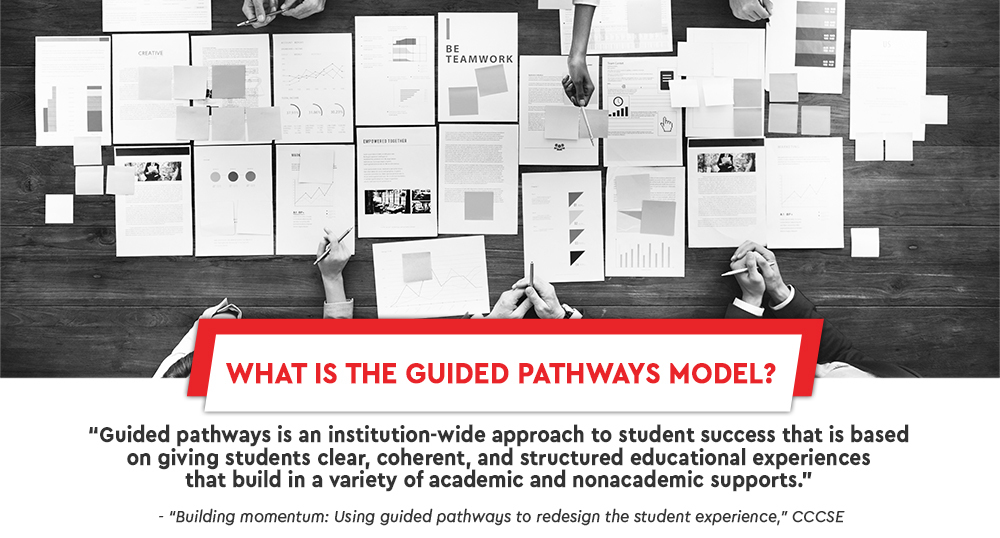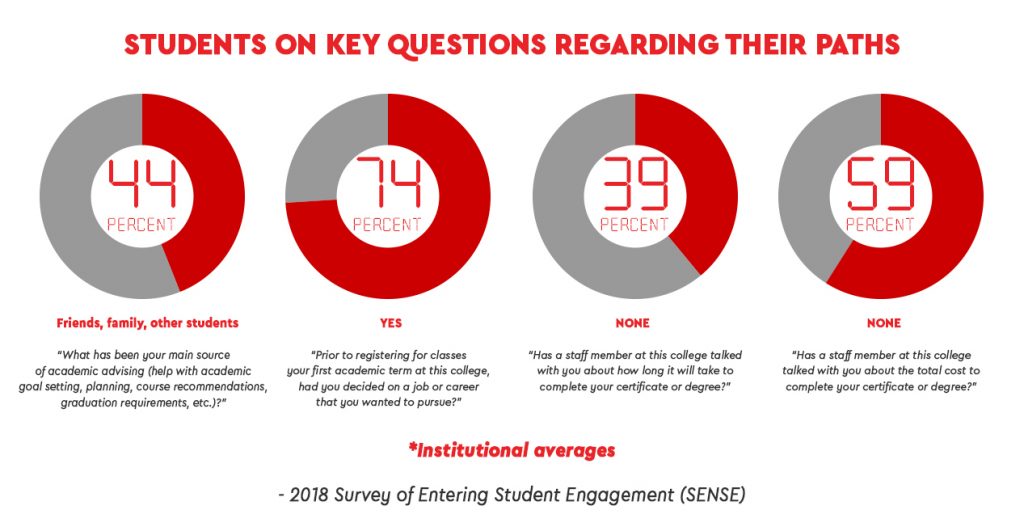58 Percent of Faculty Believe ‘Guided Pathways’ in U.S. Colleges Can Improve Student Outcomes
- The American Association of Community Colleges launched the first national project focused on guided pathways involving 30 institutions in 2015.
- More than 300 colleges are implementing guided pathways reforms as part of formal national or state initiatives.
- The guided pathways model has four pillars: Clarify the paths; Help students get on a path; Help students stay on their path; and ensure students are learning.
- Fifty-eight percent of faculty respondents who reported that their colleges are implementing guided pathways believe that these will improve student outcomes.
- Thirty six percent of faculty are not involved in guided pathways. Forty nine percent said they needed more professional development. Forty five percent said they know little or nothing about guided pathways.
Dubbed “Building momentum: Using guided pathways to redesign the student experience,” it collected data from over 100,000 community college students and 7,000 community college faculty members. The report, which was published in 2020, also presented the first national baseline data on guided pathways through feedback from students and faculty.
“The guided pathways model helps colleges start with students’ end goals in mind so that from the beginning, colleges help students explore career and transfer options and interests,” said CCCSE executive director Dr. Linda L. García.
The national report complements study initiatives by the American Association of Community Colleges (AACC) within the last 10 years. In 2012, the AACC “set forth the three Rs: Redesign students’ educational experiences. Reinvent institutional roles. Reset the system to create incentives for student and institutional success.” In 2015, the association launched the first national project focused on guided pathways that involved 30 institutions across the United States, and growing.
“Since that time, many more colleges have committed to this transformational journey,” Garcia said.
Guided Pathways Pillars
As of 2019, “more than 300 colleges are implementing guided pathways reforms as part of formal national or state initiatives,” said Dr. Davis Jenkins, senior research scholar at Columbia University. Guided pathways in education is the most extensive US educational institution reform movement in years, reiterated Jenkins.
The guided pathways model reforms an educational institution from the ground up, focusing more on a student’s educational experience inside and outside the campus throughout his or her college years. Ideally, schools benefit from an increase in completion rates and domestic and international students enjoy better post-graduation success.
“Colleges implementing guided pathways are reviewing and more clearly mapping their programs to ensure that they lead to good jobs and further education,” said Jenkins.
According to the CCCSE report, the guided pathways model has four pillars:
- Clarify the Paths
- Help Students Get on a Path
- Help Students Stay on Their Path
- Ensure Students Are Learning
With the guided pathways model gaining momentum among higher education institutions in the US, Garcia said the report aims to “understand how students are experiencing the movement.”
“Where are we making progress in transforming the student experience, and where is attention still needed?” asked Garcia.

Focus: Improving Student Experience
While its definition and clear-cut goals make it sound easy, incorporating the guided pathways model into a higher education institution’s existing structure has challenges to address, evidenced by current student experiences highlighted in the CCCSE report.
These challenges include a variety of aspects like onboarding, advising, curriculum, instruction, scheduling, and technology. Also, drastic changes to past practices may take more time. Some, if not all programs, may have to be redesigned, new policies will have to be implemented, and the practice of guided pathways will have to be more at the forefront.
Guided by its pillars as a background, the students’ response to some of the questions on the 2018 Survey of Entering Student Engagement (SENSE) reveal the importance of following through all the pillars from beginning to end. For instance, not all college plans were made with the proper advice from educational institutions or from any of its staff. Also, a majority of students (59 percent) had not received proper communication on the financial costs it would take to be able to complete a degree.

Engaged Faculty Equals Engaged Students Equals Equity
Guided pathways are implemented by faculty members, making them a very critical part of the country-wide institutional reform. They have a range of important tasks from the designing of pathways and advising their students to the reimagining of curricula and instructional practices.
A majority of faculty respondents (58 percent) who reported that their colleges are implementing guided pathways believe that these will improve student outcomes.
However, 36 percent said they are not involved in the guided pathways program at all. Almost half (49 percent) said they needed more professional development on the model. Forty-five percent of faculty also said they know “very little” or “nothing” about guided pathways.
“Guided pathways is about creating an airtight, coordinated care network around our students to ensure that we accelerate their progression and, if necessary, catch them before they fall,” said Gregory Adam Haile, president of Broward College in Florida. Broward is one of 28 public community colleges in the Florida system.
From the start of a student’s educational path up until the end right before landing his or her desired career, he or she has spent time, effort, and resources inside the classroom. For the model of guided pathways to completely sweep over United States colleges, especially during a critical time currently with the pandemic, engaged faculty is a priority for its effective implementation and long-lasting effects.
“Due to COVID-19, some students have had to alter their educational plans; therefore, timely and intrusive academic advising and career counseling will be vital resources for them,” Garcia said in an article, with Courtney Adkins, assistant director of publications at CCCSE.
“An essential condition of the guided pathways model is a commitment to equity in student outcomes. And in order for there to be equity in student outcomes, equity-minded practices must be in place.” (SUNEETHA QURESHI)

SUNEETHA QURESHI
MSM President - Global
She has an impeccable track record of successfully launching the representative offices in Asia and Africa of many North American and European higher education institutions. Her key strengths include hiring, training, and developing teams as evidenced by the successful results of the dedicated in-country college and university client teams.
Suneetha also has taken the lead in developing several initiatives at MSM, including building robust standard operating procedures, the Rise ‘n Shine team engagement platform, and the organization’s data analytics and audit segments.
Data sources:
Building momentum: Using guided pathways to redesign the student experience (2020). Center for Community College Student Engagement. Retrieved from https://cccse.org/sites/default/files/BuildingMomentum.pdf
Garcia, L. (2021, March 25) Why the Work of Guided Pathways Is Valuable for Students. The Evolllution. Retrieved from https://evolllution.com/programming/program_planning/why-the-work-of-guided-pathways-is-valuable-for-students
